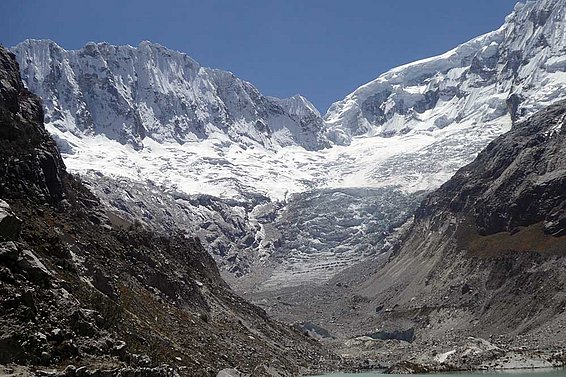Peru GROWS - Peruvian glacier retreat and its impact on water security
Francesca Pellicciotti
2019 - 2021

The aim of Peru GROWS is to investigate the impacts of ongoing and projected climate change on glacier retreat and water resources in the Rio Santa catchment in the Cordillera Blanca, Peru. We will then determine ways that the community could adapt its water use to enhance the resilience of Peruvian communities and ecosystems to the projected changes. The project is organised into four sections, or workpackages. Each workpackage has its own scientific objectives, with the results of earlier workpackages often being inputs into the later workpackages. Each workpackage has at least one Peruvian and one UK lead, who together are in charge of delivering the work in that section. Please contact the workpackage leads if you would like more information about the methodology employed.
Workpackage 1: led by Alejandro Diez, Fernando Gonzalez and Andrew Orr
This team aims to map the baseline socio-economic and water resources situations in the Rio Santa catchment and identify the dependence of ecosystems, agricultural production, food security, energy production and socio-ecological vulnerability on the hydrological regime.
Workpackage 2: led by Edwin Loarte and Francesca Pellicciotti
This team aims to quantify how glacier volumes and glacier runoff in the catchment will change in the future. The work will also improve the understanding of the processes which control the mass balance of the glaciers and the pattern of runoff from the catchment in response to climate change.
Workpackage 3: led by Martín Timaná and Tim Hess
This team aims to model the associated impacts of the projected changes in the hydrological regime on ecosystems, agriculture, food security, energy production and socio-ecological vulnerability.
Workpackage 4: led by Fabian Drenkhan and Bayo Adebayo
This team aims to work closely with stakeholders to devise robust adaptation and mitigation strategies on both local and regional scales in response to the changes in the hydrological regime. The mitigation measures will be devised to promote poverty reduction, equitable sharing of resources and economic growth.
Study area(s)
- Rio Santa basin, Peru: 9°31’38.87”S 77° 31’44.0” W
